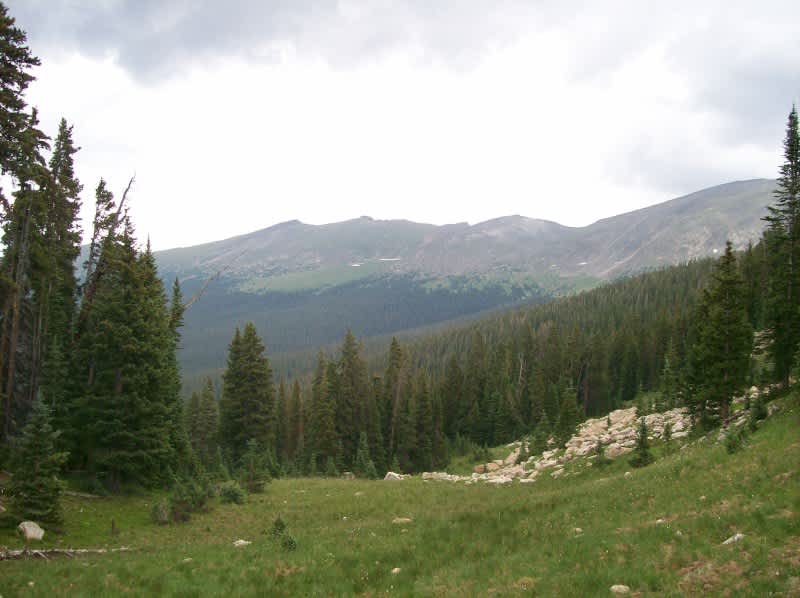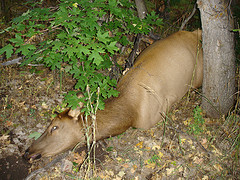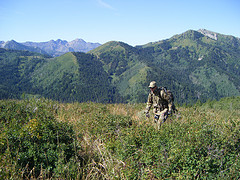Hunting Big Bull Country With a Bow and a Cow Tag
Mike O'Reilly 06.20.11

When I lived in Utah, sometimes non-resident hunters would call and ask my advice about where to bowhunt for big bull elk in Colorado or Utah. More often than not I would suggest the hunter re-organize his priorities and do what I did when I first moved Out West — buy an over-the-counter cow or spike tag for a limited entry (draw-only) bull area. Why? First, a cow tag is much cheaper, second, there are more cows, so your chances of killing something are higher. The main reason I suggest this options — and the reason I tell people to do it in a limited entry, “big bull” unit — is because the hunt is almost guaranteed to include a lot of close encounters with elk, including big bulls. In my opinion, getting within bow range of a trophy bull, but shooting the cow next to him is just as good as getting bull, and better; I get the meat, but I don’t have to pack out the head, I don’t have to pay for the head to be mounted, and my house doesn’t have to have twelve-foot ceilings — only a freezer, an oven, and a kitchen table. Oh yeah, and you’ll save thousands by not hiring a guide and not paying for the higher-priced bull tag.
I was not a resident when I shot my first cow in Utah; I’d only been in town a few weeks. Another Michigan transplant, Paul, was a childhood friend of mine and had been in Utah long enough to explore the Central Nebo spike only area, so that’s where we headed in mid-September of 2004.
The weather was perfect for an overnight hunt. We parked at a gravel pull-off near the summit of the Mt. Nebo Scenic Loop, at about 8,000 feet above sea level. After hiking down the steep hillside for about a thirty minutes we found a good spot to set up the tent on the edge of a grassy, lightly wooded clearing, tucked into some cedars. As we discussed our game plan for the following morning we were interrupted by a bone-chilling bugle. We were already pumped up to hunt, but the bull’s scream sent us into overdrive. With only a few minutes of daylight, we scrambled to get out bows, releases and face masks, and dashed off toward the sound of the call, until we came to a clearing only a hundred yards from our campsite. Suddenly a massive bull — surely the one we’d just heard — strolled casually into the open only about forty yards downhill, crossing from left to right. I counted six points on one side as he moved across a patch of sunlight and back into the dark timber. I couldn’t get over how majestic this bull looked, and the way he moved like a ghost.
Of course, the fact that we were only able to hunt cows and spikes in the area is probably the reason we had an encounter with such a great bull. It’s a testament to the success of the animal management the state of Utah has achieved over the years. Because only spike and cow tags are available for the unit we were hunting in, the hillsides were crawling with massive bulls.
We didn’t sleep well. Every time we were about to doze off we were awakened by another scream of a nearby bull. We got up an hour before sunrise, made some tea and tried to decide toward which bugling monster we would hike. The closest sounds were coming from below and just to the north, so we headed downhill slowly, occasionally squeaking the cow call.
Just as shooting light came, we stumbled into the first group of animals, and the woods erupted as a heard of cows smashed their way through the brush. But they didn’t go far. We crouched down and I blew the cow call. They responded immediately, sending three cows back to find out who was lost. Paul had a clear shot at one of them, but he was exposed, and as he drew his bow, he was spotted and the trio hightailed it uphill.

We weren’t discouraged. The main group had most likely split up, which would be highly conducive to calling in an individual cow. Rather than chase them, we decided to head downhill a bit farther, and soon we found ourselves in the perfect scenario; dark timber which wasn’t very thick so there were plenty of shooting lanes, and a hillside crisscrossed with elk runs. We decided to sit for a few minutes, but before we could rest there was more action.
I was behind a large log, and Paul was a twenty feet uphill from me, when we heard a single cow call. I hit my own cow call twice and no sooner had I nocked an arrow when a cow came charging from some thick stuff below. She was facing me at twenty-five yards, but still behind a tree, giving me no shot. I could tell she was nervous, and wasn’t about to stand there for long. I drew my bow as she bounded about four jumps to her left before stopping squarely in the last possible shooting lane. It was a close to instinctive shooting as you can get with a compound; I accounted for the yardage, the downward angle, and let off a perfect shot to the lungs. I never actually saw the arrow hit, but both Paul and I agreed it sounded good.
After waiting about an hour we started looking for blood, which proved very difficult. I always prefer to find blood rather than speculate on the direction the animal ran, but we ended up having to walk a ways downhill, and do a little guesswork. We got on several different runs before we picked the right one and found some blood. She had stopped in several places and bled large amounts, and we both knew it was a fatal hit. We found her only about fifty yards later. She had run straight back to the thicket from which she had first emerged upon hearing the cow call.
As every successful bowhunter knows the real work starts the minute you release an arrow. The cow I shot was small, and I received a little ribbing about it from Paul, but neither one of us wished it was any bigger as we tried to get it out of the woods! We decided to leave the animal where it was, hike back up and break camp, then carry our gear back up the mountain to the truck.That only took a couple of hours. Then, with empty packs, we hiked back down to the animal. This is where the GPS really saved us. There is absolutely no way we would have found the elk again without the GPS. Heck, after the kill we could barely find our campsite with the GPS.
We loaded the front and hind quarters, plus the backstraps into our backpacks and headed back up the mountain for the second time that day. All I could think about was how happy I was that I had shot the elk first-thing in the morning. Had it been an evening kill, we would have had to spend another night in the woods and pack out the animal the next day.
It had been the most action-packed twenty-four hours of hunting I’d ever experienced, and would have remained so had I not even killed an elk. The sheer excitement of being around so many huge, vocal animals was worth every bit of hiking and preparation.
The following year I killed a much larger cow in almost the exact same area, under very similar circumstances, although it was in the evening, not the morning. And it was only a couple of miles from where I killed my large bull in 2008, after finally drawing the tag. Most guys apply for five or six years before being successful in getting a Central Nebo tag, but I only applied for three years.
For people just getting into elk hunting, or even for experienced, non-resident hunters with a limited schedule and/or budget I would strongly suggest doing a cow or spike-only trip. The only way you can expect to learn a lot about elk is to hang out with as many of them as possible. Of all your public land hunting options, limited entry, big-bull elk units are your best bet because these areas are managed to produce large, healthy groups of elk, and they are not being as heavily hunted as the elk found on most public land.



